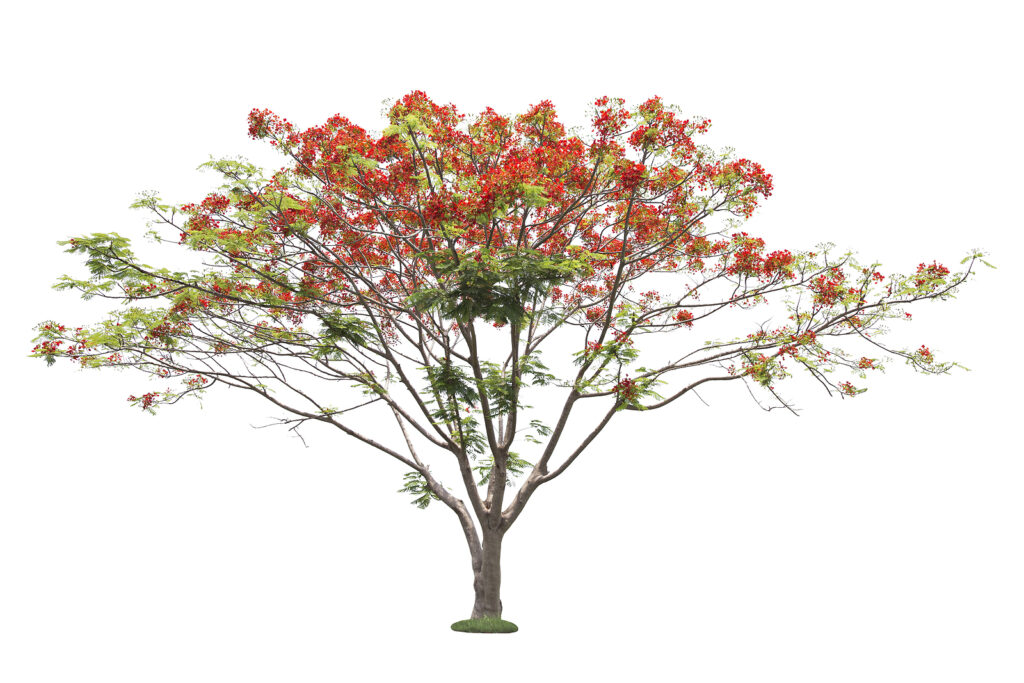Caesalpinia — which is synonymous with Poinciana–are grown for their panicles of 30 to 40 flowers that can be bright yellow, orange, or red depending on the variety. Caesalpinia are commonly known as bird of paradise bush or dwarf poinciana
Caesalpinia are fast-growing shrubs of small trees with finely cut, filmy foliage. The plants are open and airy. They are tropical and semi-tropical plants that grow in Zones 9 to 12.
In frost-free regions Caesalpinia can be grown as specimen plants or in a large shrub border. Where not hardy, they can be grown in a cool greenhouse.
Caesalpinia is a genus of 70 or more evergreen species. Most have a climbing habit.

Get to know Caesalpinia
- Plant type: Evergreen or deciduous shrubs or small trees
- Growing zones and range: Zones 9 to 12, but frost in Zone 9 may occasionally nip it back
- Hardiness: Tropical; will be harmed or killed by frost
- Height and width: Most reach 5-6 feet (1.5-1.8m), but old plants may grow to 10 feet (3.1m) with an equal spread
- Growth rate: Fast
- Form and habit: Climbing; the plant has a light and airy appearance
- Foliage: Light green leaves composed of many .5 inch (1.3cm) leaflets
- Flowers: Brilliant 2 inch (5.1cm) orange-red flowers, arranged in upright clusters 6-8 inches (15.2-20.3cm) across, distinguished by many red bollen-bearing stamens, which extend 2 inches (5.1cm) or more from the centers of the blossoms
- Bloom time: Summer
- Uses: Shrub borders
- Common name: Bird of paradise bush, dwarf poinciana
- Botanical name: Caesalpinia
- Family name: Fabaceae
- Origin: Tropical and subtropical regions
Where to plant Caesalpinia
- Plant Caesalpinia in full sun, but will tolerate light shade.
- Plant Caesalpinia in well-drained, slightly acid soil supplemented with leaf mold or peat moss.

When to plant Caesalpinia
- Sow Caesalpinia seeds in spring to begin flowering in late summer.
- Set container-grown plants in the garden in spring.
Planting and spacing Caesalpinia
- Space Caesalpinia 5 to 6 feet (1.5-1.8m) apart; plants may grow to 10 feet (3.1m) wide.
- Sow seed 1/4 inch deep in evenly prepared soil.
How to water and feed Caesalpinia
- Give Caesalpinia moderate to little water, and deep watering during periods of drought.
- Feed Caesalpinia with an all-purpose organic fertilizer in spring.
How to care for Caesalpinia
- Pruning season for Caesalpinia is anytime to encourage fresh branching.
Caesalpinia pests and diseases
- Caesalpinia is susceptible to attack by spider mites, whiteflies, and mealybugs.
- Caesalpinia cam be attacked by fungal canker; dieback can occur.
- Caesalpinia pods and seeds cause serious illness.
Caesalpinia propagation
- Sow seed in warm soil in spring after soaking in warm water for 24 hours.
- Root softwood cuttings in spring or greenwood cuttings in summer.

Caesalpinia varieties to grow
- Caesalpinia giiliesii (Poinciana gilliesii), Bird of paradise bush, evergreen shrub or small tree; drops leaves in cold winter. Tough, interesting, fast-growing to 10 feet (3.1m), with finely cut, filmy foliage on a rather open, angular branch structure. Blooms all summer; clusters of yellow flowers adorned with protruding, bright red, 4-5 inches (10.2-12.7cm) long stamens. Flowers attract hummingbirds.
- C. mexicana, Mexicana bird of paradise, evergreen shrub, or small tree. Moderately fast growth to 10-12 feet (3.1-3.7m); may be pruned 6-8 feet (1.8-2.4m). Foliage is coarser than that of C. pulcherrima. Blooms year-round except in coldest months, bearing lemon-yellow flower clusters 6 inch (15.2cm) long, 4 inch (10.2cm) thick.
- C. pulcherrima (also called Poinciana pulcherrima), Barbados pride, Barbados flower fence, dwarf poinciana, and Bird of paradise, deciduous shrub; may be evergreen in mild winters. Fast, dense growth to 10 feet (3.1m) tall and as wide. Dark green leaves with many .8 inch (2cm) long leaflets. Blooms throughout warm weather; flowers orange or red (rarely yellow), clustered, with long red stamens. Useful for quick screening. Act as an herbaceous perennial in the colder part of the range—freezes to ground but rebounds quickly in spring. Even if it doesn’t turn back, you can cut it back to the ground in early spring to make a more compact mound.















